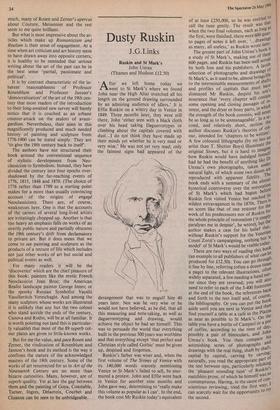Dusty Ruskin
J.G.Links
Ruskin and St Mark's John Unrau (Thames and Hudson £12.50)
A fter we left home today we ra.went to St Mark's where we found John near the High Altar stretched all his length on the ground drawing surrounded by an admiring audience of idlers.' It is Effie Ruskin on a wintry day in Venice in 1849. Three months later, they were still there, John 'either seen with a black cloth over his head taking Daguerrotypes or climbing about the capitals covered with dust...1 do not think they have made up their minds yet whether he is very mad or very wise.' He was not yet very mad; only the faintest signs had appeared of the
derangement that was to engulf him 40 years later. Nor was he very wise or he would not have believed, as he did, that all this measuring and note-taking, as well as daguerreotyping and drawing, would achieve the object he had set himself. This was to persuade the world that everything built in the previous 300 years was worthless and that everything except 'that perfect and Christian style called Gothic' must be given up, despised and forgotten.
Ruskin's father was wiser and, when the first volume of The Stones of Venice with its 140,000 words scarcely mentioning Venice or St Mark's failed to sell, he mur- mured a protest. John and Effie were back in Venice for another nine months and John gave way, determining to 'really make this volume as popular as I can'. In the end, the book cost Mr Ruskin today's equivalent The spectator 26 May 198 of at least f250,000, so he was entitled to call the tune gently. The result was that when the two final volumes, each as long as the first, were finished, there were 600 Oar" to pages of notes it left over, `...drawings as many, all useless,' as Ruskin wrote later.
The greater part of John Unrau's book Is a study of St Mark's, making
use of these 600 pages, and Ruskin has been well served by both him and his publishers. A lavish selection of photographs and drawings of St Mark's, as it used to be, almost brings life to the interminable measurements of shafts and profiles of capitals that must have dismayed Mr Ruskin, despite his son s assurance that 'every chapter will contain some opening and closing passages of in- terest, and the dryer or bony parts, in which the strength of the book consists, will neve., be so long as to be unmanageable'. In a se- cond, and relatively short, section the author discusses Ruskin's theories of co,1- our, intended for 'chapters to be written '• few coloured lithographs (by no less ae artist than T. Shotter Boys) illuminate th original Stones, but it is hard to irnagirl,e4- • how Ruskin would have indulged him se" had he had the benefit of anything like Or Unrau's own photographs, taken under natural light, of which some two dozen are reproduced with apparent fidelity book ends with a summary of the almost hysterical controversy over the restoration of St Mark's which had begun before Ruskin first visited Venice but reached Its i wildest extravagances in the 1870s. There s no scorn like that of one restorer for the work of his predecessors nor of Ruskin for the whole principle of restoration ('it sintIP'Y paralyses me in despair', he wrote), but the author makes a case for his belief that, without Ruskin's support for the Venetian Count,i lorzi's campaigning, nothing but a model' of St Mark's would be visible todaY- There are two ways of reading this book (an example to all publishers of what can be produced for £12.50). You can go hrough. it line by line, referring (often a dozen times a page) to the relevant illustrations, often widely separated, a few needing a hand Mir- ror since they are reversed; you will also need to refer to each of the 3-400 footnotes at the end of the book, the references back and forth to the text itself and, of course, the bibliography. Or you can put the book aside until you are next in Venice and then find yourself a table at a cafe in the Piazza as near as possible to St Mark's. On the, table you have a bottle of Campari or a Po` of coffee, according to the time of da2r, possibly a pair of binoculars, and John Unrau's book. You then compare astonishing series of photographs an o drawings with the real thing, shaft by shaft, capital by capital, carving by carving; naturally, you read the appropriate part of the text between sips, particularly relishing the 'pleasant sounding tune' of Ruskin s matchless prose, of which he himself was s° contemptuous. Having, in the cause of con- scientious reviewing, tried the first wall, I the dnsseceaorchely wait for the opportunity to trY h














































 Previous page
Previous page